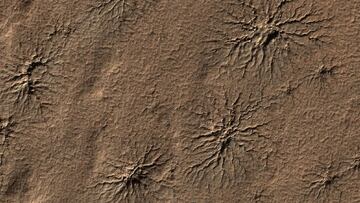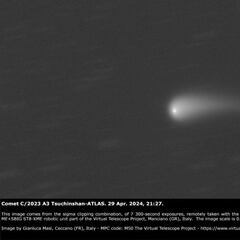What are the spider formations found on Mars? NASA explains
Space probes have captured images of intriguing spider-like formations on Mars. NASA has put forth a theory on what created these huge patterns.

In 2003, scientists first spotted a surprising feature in images taken by orbiters in the southern hemisphere of Mars. Last April, the European Space Agency’s Mars Express probe captured new images of these “spiders.”
The space agency previously explained that these geological formations were the result of the consequences of seasonal changes on Mars. NASA has agreed with this theory, and provided more details about the phenomenon.
READ ALSO: ‘Comet of the century’ to dazzle Earth in fall
Northern polar crater on Mars
— Black Hole (@konstructivizm) September 10, 2024
NASA pic.twitter.com/okjSFDKwcU
‘Spiders’ formed by the change in weather
According to NASA, each branching formation can extend more than a kilometer from end to end and include hundreds of thin “legs.” Known as “araneiformes” for their resemblance to the eight-legged animal, NASA scientists believe that these “spiders” are formed through processes that involve carbon dioxide ice.
In a study later published in The Planetary Science Journal, scientists were inspired by Kieffer’s model to understand the origin of these formations. The hypothesis holds that these cracks appear to form due to the sublimation of CO₂; that is, the process by which a substance passes directly from a solid to a gaseous state, without first going through the liquid state.
“When winter turns to spring and the remaining ice sublimates, the theory goes, what remains are the spider-like scars of those tiny eruptions,” NASA said in a statement.
The co-authors of the research recreated the extreme conditions of the Martian polar surface to understand it, using extremely low atmospheric pressure and temperatures of -185ºC.
Nature ‘a little messier than the textbook image’
Lauren McKeown of NASA’s Jet Propulsion Laboratory and leader of the study used a liquid nitrogen-cooled test chamber at JPL, the Dirty Under-vacuum Simulation Testbed for Icy Environments or DUSTIE. “I love it, it’s historic,” she said.
Related stories
Using this tool, they cooled simulated Martian soil in a container immersed in a bath of liquid nitrogen, and placed it in the chamber, where the air pressure was reduced to be similar to that of the southern hemisphere of the red planet.
“It is one of the details that explains that nature is a little more messy than the textbook image,” McKeown said.


Complete your personal details to comment